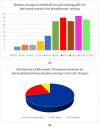Mo-Based Layered Nanostructures for the Electrochemical Sensing of Biomolecules
- PMID: 32967188
- PMCID: PMC7571038
- DOI: 10.3390/s20185404
Mo-Based Layered Nanostructures for the Electrochemical Sensing of Biomolecules
Abstract
Mo-based layered nanostructures are two-dimensional (2D) nanomaterials with outstanding characteristics and very promising electrochemical properties. These materials comprise nanosheets of molybdenum (Mo) oxides (MoO2 and MoO3), dichalcogenides (MoS2, MoSe2, MoTe2), and carbides (MoC2), which find application in electrochemical devices for energy storage and generation. In this feature paper, we present the most relevant characteristics of such Mo-based layered compounds and their use as electrode materials in electrochemical sensors. In particular, the aspects related to synthesis methods, structural and electronic characteristics, and the relevant electrochemical properties, together with applications in the specific field of electrochemical biomolecule sensing, are reviewed. The main features, along with the current status, trends, and potentialities for biomedical sensing applications, are described, highlighting the peculiar properties of Mo-based 2D-nanomaterials in this field.
Keywords: Mo-layered compounds; biomolecules; electrochemical sensors; nanosheets.
Conflict of interest statement
The authors declare no conflict of interest.
Figures










Similar articles
-
Functionalization of 2D MoS2 Nanosheets with Various Metal and Metal Oxide Nanostructures: Their Properties and Application in Electrochemical Sensors.Biosensors (Basel). 2022 Jun 2;12(6):386. doi: 10.3390/bios12060386. Biosensors (Basel). 2022. PMID: 35735534 Free PMC article. Review.
-
Structuring Au nanoparticles on two-dimensional MoS2 nanosheets for electrochemical glucose biosensors.Biosens Bioelectron. 2017 Mar 15;89(Pt 1):545-550. doi: 10.1016/j.bios.2016.03.024. Epub 2016 Mar 13. Biosens Bioelectron. 2017. PMID: 26997639
-
Environmental Applications of 2D Molybdenum Disulfide (MoS2) Nanosheets.Environ Sci Technol. 2017 Aug 1;51(15):8229-8244. doi: 10.1021/acs.est.7b01466. Epub 2017 Jul 17. Environ Sci Technol. 2017. PMID: 28661657
-
Label-free Electrochemical Detection of CGG Repeats on Inkjet Printable 2D Layers of MoS2.ACS Appl Mater Interfaces. 2020 Nov 18;12(46):52156-52165. doi: 10.1021/acsami.0c14912. Epub 2020 Nov 5. ACS Appl Mater Interfaces. 2020. PMID: 33151065
-
Fabrication of Graphene/Molybdenum Disulfide Composites and Their Usage as Actuators for Electrochemical Sensors and Biosensors.Molecules. 2019 Sep 17;24(18):3374. doi: 10.3390/molecules24183374. Molecules. 2019. PMID: 31533260 Free PMC article. Review.
Cited by
-
Defect-Driven MoS2 Nanosheets toward Enhanced Sensing Sensitivity.ACS Omega. 2024 Jun 13;9(25):27065-27070. doi: 10.1021/acsomega.4c00379. eCollection 2024 Jun 25. ACS Omega. 2024. PMID: 38947855 Free PMC article.
-
Palladium Hydroxide (Pearlman's Catalyst) Doped MXene (Ti3C2Tx) Composite Modified Electrode for Selective Detection of Nicotine in Human Sweat.Biosensors (Basel). 2022 Dec 29;13(1):54. doi: 10.3390/bios13010054. Biosensors (Basel). 2022. PMID: 36671889 Free PMC article.
-
Electrospun cobalt-doped 2D-MoSe2/polypyrrole hybrid-based carbon nanofibers as electrochemical sensing platforms.Mikrochim Acta. 2024 Jan 4;191(1):75. doi: 10.1007/s00604-023-06078-2. Mikrochim Acta. 2024. PMID: 38172450 Free PMC article.
-
2D materials: increscent quantum flatland with immense potential for applications.Nano Converg. 2022 Jun 6;9(1):26. doi: 10.1186/s40580-022-00317-7. Nano Converg. 2022. PMID: 35666392 Free PMC article. Review.
-
HER-2-Targeted Electrochemical Sensors for Breast Cancer Diagnosis: Basic Principles, Recent Advancements, and Challenges.Biosensors (Basel). 2025 Mar 25;15(4):210. doi: 10.3390/bios15040210. Biosensors (Basel). 2025. PMID: 40277524 Free PMC article. Review.
References
-
- Neri G. Thin 2D: The New Dimensionality in Gas Sensing. Chemosensors. 2017;5:21. doi: 10.3390/chemosensors5030021. - DOI
-
- Cao X., Halder A., Tang Y., Hou C., Wang H., Duus J.O., Chi Q. Engineering two-dimensional layered nanomaterials for wearable biomedical sensors and power devices. Mater. Chem. Front. 2018;2:1944–1986. doi: 10.1039/C8QM00356D. - DOI
Publication types
MeSH terms
Substances
LinkOut - more resources
Full Text Sources
Other Literature Sources

